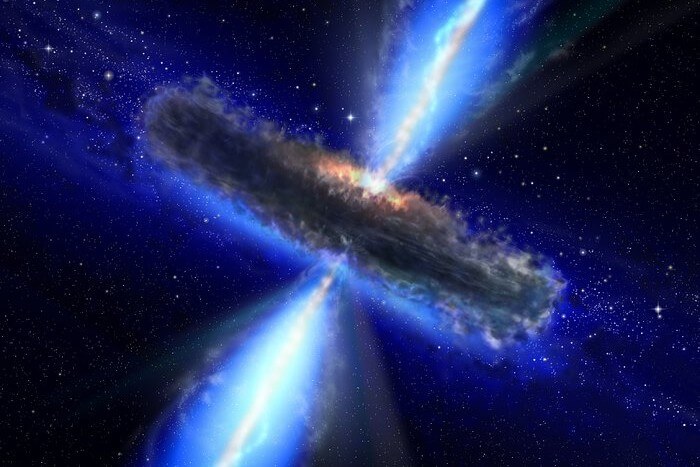Astronomers have made an intriguing discovery suggesting that supermassive black holes, concealed by dust, have a higher likelihood of growth and releasing tremendous energy when residing in galaxies that are predicted to collide with neighbouring galaxies.
The recent study, led by researchers from Newcastle University, has been published in Monthly Notices of the Royal Astronomical Society.
Galaxies, such as our very own Milky Way, host supermassive black holes at their cores. These black holes possess masses equivalent to millions or even billions of times that of our Sun. Their growth occurs as they consume gas that falls into them. However, the factors that drive the gas close enough to the black holes for this process to take place remain an ongoing mystery.
One hypothesis proposes that when galaxies draw near to one another, their gravitational forces pull them together, resulting in a merger and the formation of a larger galaxy.
During the final stages of its journey into a black hole, gas illuminates and generates an immense amount of energy. Typically, this energy is detected using visible light or X-rays. However, the astronomers involved in this study could only detect the growing black holes using infrared light. They utilized data from various telescopes, including the Hubble Space Telescope and the infrared Spitzer Space Telescope.
The researchers devised a new technique to determine the likelihood of two galaxies being in close proximity and expected to collide in the future. They applied this innovative method to hundreds of thousands of galaxies in the distant universe, focusing on galaxies formed 2 to 6 billion years after the Big Bang. The aim was to enhance our understanding of the so-called “cosmic noon,” a significant period during which most of the galaxy and black hole growth in the Universe is believed to have occurred.
Gaining insight into the growth of black holes during this crucial time is fundamental in modern-day galactic research. It could potentially provide us with a glimpse into the supermassive black hole situated within our Milky Way and shed light on the evolutionary trajectory of our galaxy over time.
Given the immense distances involved, only a small number of galaxies from the cosmic noon period meet the required criteria for obtaining precise measurements of their distances. This makes it exceptionally challenging to determine with high precision if any two galaxies are indeed in close proximity to one another.
This study presents a novel statistical method designed to overcome previous limitations in accurately measuring the distances between galaxies and supermassive black holes during the cosmic noon period. By employing a statistical approach, the researchers can determine galaxy distances by analyzing images captured at different wavelengths, thereby eliminating the need for spectroscopic distance measurements for individual galaxies.
The data expected to arrive from the James Webb Space Telescope (JWST) in the coming years holds the potential to revolutionize infrared studies and unveil further secrets regarding the growth of these enigmatic, dust-obscured black holes.
Sean Dougherty, a postgraduate student at Newcastle University and the paper’s lead author, explains that their innovative approach involves the statistical examination of hundreds of thousands of distant galaxies. By assessing the likelihood of any two galaxies being in close proximity and potentially on a collision course, they can gain valuable insights.
Dr Chris Harrison, co-author of the study, notes the challenges faced in detecting these supermassive black holes. He highlights that the X-ray light traditionally used by astronomers to locate growing black holes is blocked and undetectable by telescopes. However, these same black holes can be detected using infrared light emitted by the hot dust surrounding them.
Dr Harrison adds that the difficulties in finding these black holes and establishing precise distance measurements have previously posed challenges in studying distant “cosmic noon” galaxies. However, with the arrival of the JWST, they anticipate discovering many more of these hidden growing black holes. The enhanced capabilities of the JWST will facilitate the discovery of these elusive black holes, allowingus to study a greater number of them, including the most elusive ones. Consequently, we will be able to deepen our understanding of the dust surrounding these black holes and ascertain the prevalence of such phenomena in distant galaxies. The insights gained from these discoveries will contribute to our knowledge of the intricate mechanisms underlying the growth and evolution of supermassive black holes.
It is clear that this study marks a significant milestone in the field of galactic research. By unraveling the mysteries of supermassive black holes concealed by dust, astronomers have opened up new avenues for exploration and expanded our understanding of the cosmic phenomena that shape our universe. As we eagerly anticipate the data from the JWST, the future holds the promise of even greater revelations and breakthroughs in our quest to comprehend the enigmatic nature of these celestial giants.

